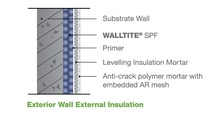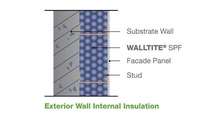Wall Insulation
Exterior wall external insulation
Basic structure
WALLTITE® exterior wall external insulation typically consists of 5 layers: substrate wall, WALLTITE® spray polyurethane foam (SPF), primer, insulation levelling mortar, anti-crack polymer mortar with embedded AR mesh. Picture 1 below shows the structure.

Advantages of the system
Compared to panel exterior wall external insulation systems, WALLTITE® exterior wall external insulation system has the following advantages:
- Higher R value because of low thermal conductivity
- Thermal setting insulation material, turns to char without melting when on fire.
- Self-adhesive insulation and no binder required
- Better adhesion to substrate, best suited for coastal areas with strong negative air pressure
- Seamless insulation best suit for curved or complicated exterior wall design.
Exterior wall internal insulation
Basic structure
WALLTITE® exterior wall internal insulation typically consists of 4 layers: substrate wall, stud, WALLTITE® spray polyurethane foam (SPF) and facade panel. Picture 2 shows the structure.

Advantages of the system
Compared with internal insulation by panels or loose filling insulation materials, WALLTITE® internal insulation has the following advantages:
- Maximum usable internal room space because of its low thermal conductivity which translates to the lowest insulation thickness for achieving the same R value compared to other commercially used insulation materials.
- Self-adhesive spray applied insulation requires no binder for substrate wall; saves material and enables fast construction.